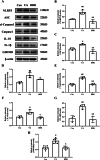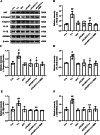Berberine attenuates uric acid-induced cell injury by inhibiting NLRP3 signaling pathway in HK-2 cells
- PMID: 37193772
- PMCID: PMC10497693
- DOI: 10.1007/s00210-023-02451-3
Berberine attenuates uric acid-induced cell injury by inhibiting NLRP3 signaling pathway in HK-2 cells
Abstract
Hyperuricemia (HUA) is a common chronic metabolic disease that can cause renal failure and even death in severe cases. Berberine (BBR) is an isoquinoline alkaloid derived from Phellodendri Cortex with strong antioxidant, anti-inflammatory, and anti-apoptotic properties. The purpose of this study was to investigate the protective effects of berberine (BBR) against uric acid (UA)-induced HK-2 cells and unravel their regulatory potential mechanisms. The CCK8 assay was carried out to detect cell viability. The expression levels of inflammatory factors interleukin-1β (IL-1β) and interleukin-18 (IL-18) and Lactate dehydrogenase (LDH) were measured using Enzyme-linked immunosorbent assays (ELISA). The expression of the apoptosis-related protein (cleaved-Caspase3, cleaved-Caspase9, BAX, BCL-2) was detected by western blot. The effects of BBR on the activities of the NOD-like receptor family pyrin domain containing 3 (NLRP3) and the expression of the downstream genes were determined by RT-PCR and western blot in HK-2 cells. From the data, BBR significantly reversed the up-regulation of inflammatory factors (IL-1β, IL-18) and LDH. Furthermore, BBR down-regulated protein expression of pro-apoptotic proteins BAX, cleaved caspase3 (cl-Caspase3), cleaved caspase9 (cl-Caspase9), and enhanced the expression of antiapoptotic protein BCL-2. Simultaneously, BBR inhibited the activated NLPR3 and reduced the mRNA levels of NLRP3, Caspase1, IL-18, and IL-1β. Also, BBR attenuated the expression of NLRP3 pathway-related proteins (NLRP3, ASC, Caspase1, cleaved-Caspase1, IL-18, IL-1β, and GSDMD). Furthermore, specific NLRP3-siRNA efficiently blocked UA-induced the level of inflammatory factors (IL-1β, IL-18) and LDH and further inhibited activated NLRP3 pathway. Collectively, our results suggested that BBR can alleviate cell injury induced by UA. The underlying unctionary mechanism may be through the NLRP3 signaling pathway.
Keywords: Berberine; Hyperuricemia; NLRP3; Uric acid.
© 2023. The Author(s).
Conflict of interest statement
The authors declare no competing interests.
Figures








References
-
- Abeles AM (2015) Hyperuricemia Gout and Cardiovascular Disease: An Update. Curr Rheumatol Rep 17:3. 10.1007/s11926-015-0495-2 - PubMed
-
- Chen Y, Luo L, Hu S et al (2022) The chemistry processing and preclinical anti-hyperuricemia potential of tea: a comprehensive review. Crit Rev Food Sci Nutr 1–26. 10.1080/10408398.2022.2040417 - PubMed
Publication types
MeSH terms
Substances
Grants and funding
LinkOut - more resources
Full Text Sources
Research Materials
Miscellaneous

